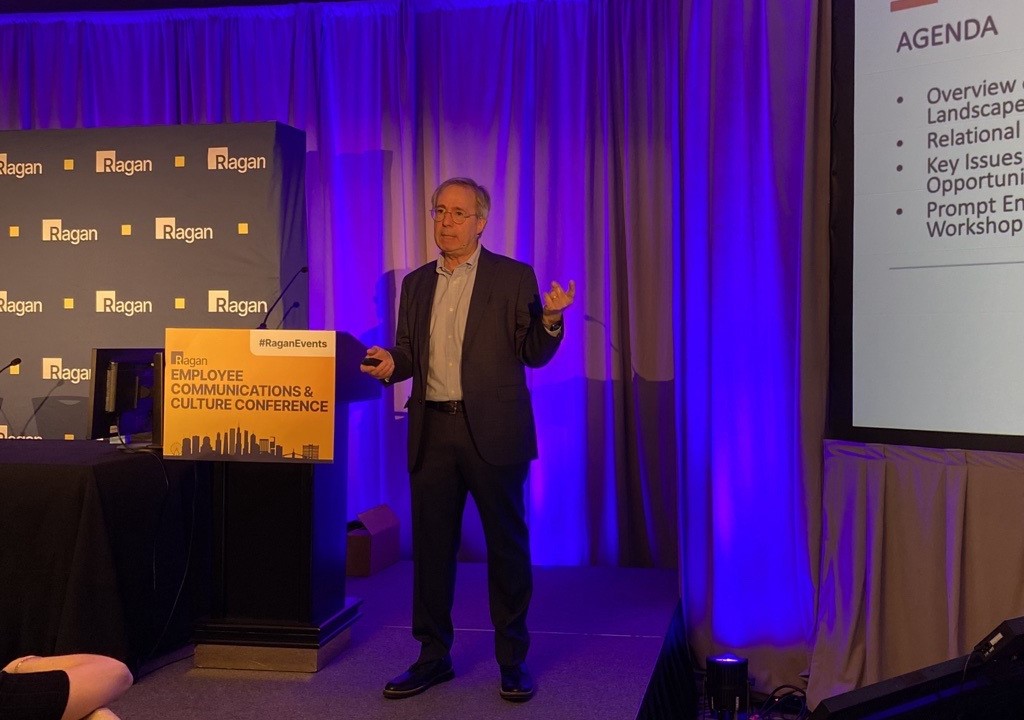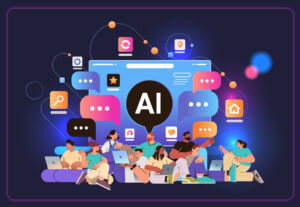How communicators can rethink workflows and creativity with AI
Digital trends and AI expert Martin Waxman says the emphasis with AI is switching from productivity to innovation — and that’s a good thing for the human element.

The breakneck pace at which artificial intelligence is growing and evolving makes it easy to feel burdened by what many have termed “FOBO” in recent years — fear of becoming obsolete.
On top of that, the complicated ethical and operational challenges that surround AI, such as intellectual property rights, embedded bias, data safety and privacy, leave many communicators unsure what tools they should be adopting and skills they should be honing to prepare for an AI-infused workplace.
To demystify these complexities, Ragan invited Martin Waxman to join us for an interactive preconference workshop during our 2024 Employee Communications and Culture Conference. Waxman is a PR veteran and educator at the York Schulich School of Business and associate director of the Future of Marketing Institute who now specializes in AI research and digital marketing trends and educates other professionals in the future of AI and prompt engineering.
In his session, he looked to the future of AI as a tool for communicators and offered some keen advice for rethinking how AI fits into your organization’s processes.
The state of AI affairs
Waxman’s tone was generally optimistic, yet realistic as he confirmed what many know to be true: That AI will revolutionize communications and relationship-building, but we’re not quite sure what that revolution will look like or what the consequences might be.
He acknowledged both the anxieties, from AI replacing jobs to robots taking over the world, and the possibilities, but especially the potential for even the average user. “We’re all beginners,” he said. “Any of us can stumble upon a brilliant or breakthrough prompt.”
He also is more hopeful about job replacement due to AI thanks to that potential: “Last year was all about productivity, and it seems to be moving more toward innovation,” he said, and framed this shift as beneficial because productivity implies doing “more with less people,” while innovation requires people to carry out.
The trouble is, many organizations aren’t investing in AI to the degree they should — according to LinkedIn’s 2024 Workplace Learning Report, 80% of employees say they want to learn AI skills, but only 38% of US executives are currently helping their employees become more AI-adept.
Creative output as data
Waxman broke down three different types of AI, only one of which has been fully realized.
For instance, Artificial General Intelligence (AGI), refers to AI or bots with intelligence and autonomy that perform at the same level as or higher than humans and even understand social dynamics. Waxman cited The Terminator and Westworld as fictional examples. Big Tech companies such as Google, Apple and Meta are in pursuit of this technology, but have not yet fully achieved it. The next theoretical level after this is Artificial Super-Intelligence (ASI), also known as The Singularity, when the intelligence of AI overcomes all of human intelligence. (Think along the lines of the “robot overlords” people sometimes joke about.)
But the moment, where we are now is Artificial Narrow Intelligence (ANI), or as Waxman called it, Narrow AI, under which generative AI falls: It takes in data — including not just numbers but words, images and video — and synthesizes it into output based on the way it’s prompted.
He encouraged attendees to rethink their own creative output.
“Communicators are data producers,” Waxman said. “We produce words — that’s natural language processing data. We produce images and videos. We have to start thinking about what we produce as data, and think about how to categorize it, store it and name it.”
For example, storing images, videos, blog post text and even AI prompts in a file structure much as IT professionals do makes it available for later use.
Organizing this creative output in the same way you organize other data can prevent it from being stored in “little data islands” as he termed it, and instead integrate it and optimize it for use across your organization. He suggested working with IT teams and other data gatekeepers to assist with categorization and naming conventions.
Developing a generative AI workflow
In the future, Waxman noted that communicators will be the stewards of AI use cases within their organizations, monitoring and providing counsel around key issues such as bias embedded in AI output, data privacy, trust, alignment of uses and tools across departments, accuracy of output, copyright issues, and transparency around the use of AI to create assets. Communicators will be the ones writing and helping to enforce these policies and protocols.
“Most of us think about how we can use AI as a creative assistant, and that’s good, but we need to get beyond that, and come up with innovative ways of using AI,” Waxman said.
He advised attendees to think outside of that assistant box and identify opportunities for novel uses based on tasks and jobs, as well as learning and development initiatives around AI for various business functions. Identify what tools do and how they should be categorized, whether it’s chatbots for customer service, image and video generators for creative teams, project management, translation and beyond.
Communicators will also need to think through the balancing acts involved, like the implications for both efficiency and employee culture, and determine who all should take responsibility for AI tools and their uses, and who should oversee those uses.
Otherwise, he predicts, “There will be an AI crisis, but it won’t be a crisis with the AI itself — it will be with human oversight.”
Are you prepared for an AI-driven future? Check out resources and workshops tailored to communicators at RaganTraining.com.
Jess Zafarris is the director of content at Ragan and PR Daily, and an author, editor and social media strategist.







